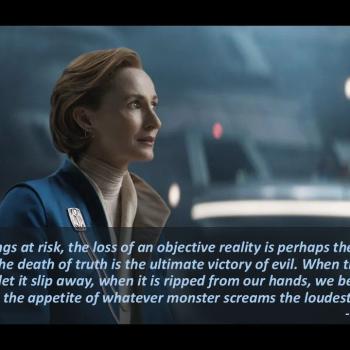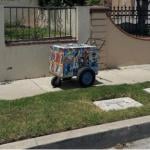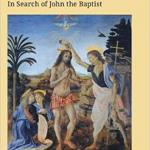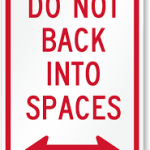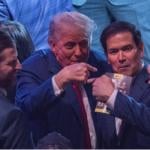Two pieces of Biblical studies humor have resurfaced in the biblioblogosphere. First, here’s Bultmann reads Mother Goose:
Bultmann Reads Mother Goose
by Jack Lundquist
I–A: Hey diddle-diddle,
I-B: The cat and the fiddle,
II–A: The cow jumped over the moon,
II–B: The little dog laughed to see such sport,
III–: And the dish ran away with the spoon.
Authorship and Date
Internal evidence rejects the view that wehave here an original composition by Mary (Mother) Goose of Boston(1686–1743).[1] The phrasing of I–A is definitely late eighteenthcentury, since the Goose Period would have rendered it “diddley-diddley” (and thus “fiddley” in I–B). Furthermore, the sequence “cat-cow-dog-dish” represents an obvious redaction and is a compilation ofat least four different accounts.[2] Thus, the author of the piece isunknown,[3] and its date set between 1780 and 1820.[4] The Sitz imLeben of the Depression of 1815 may be reflected in III.2.
Text
The received text is very corrupt. The mythological elementin II–A is typical of many other interpolations, as is the anthropomorphism in II–B.[5] However, I–A may be original, excluding,of course, the “hey.”[6]3.
Interpretation
Stripped of its thought forms, the piece tells us of something revolutionary as existentially encountered by three animals, two cooking implements, and one musical instrument.[7]
————————————————————
1. Discussed in F. Sauerkraut, Gooses Werke, vol. XXVII, pp. 825–906; G.F.W. Steinbauger, Gooserbrief, pp. 704–8636; Festschrift fur Baronvon Munchausen, pp. XIII–XX; R. Pretzelbender, Die Goosensinger vomBostom, p. 10.
2. See P. Katzenjammer in Goosengeschichtliche Schule Jahrbuch, vol.X.
3. Some attribute it to Mary’s grandson, Wild Goose (1793–1849), andother Wild Goose’s nephew, Cooked (1803–1865). Both views are challenged by A. Kegdrainer in the thirty volume prolegomenon, Gooseleiden, vol. XV.
4. F. Pfeffernusse contends it is an English translation of a German original by the infant Wagner. See his Goose und Volkgeist, pp. 38–52; see also his Geist und Volkgoose, pp. 27–46.
5. The authenticity of both II–A and II–B is poorly argued by the reactionary American Goosologist, Carl Sanbag in his Old Glory and Mother Goose (see vol. IV, The Winters in the South, p. 357).
6. The meaning of the word “hey” is now hopelessly obscure. See my articles on “Hey, That Ain’t” and “Hey, What The” in Goosengrease,Fall, 1942.
7. Perhaps an eclipse of the moon?
And here’s Tom Wright reads Humpty Dumpty by Jason Hood:
Tom Wright Reads Humpty Dumpty
Humpty Dumpty sat on a wall
Clearly the writer is telling an Israel story, and here alludes to the Temple. This echoes other lines in early 2nd Nursery Literature, such as Mother Hubbard’s cupboard (the “storehouse” of the Temple) and the bone (resurrection life) which she sought for her dog (“Gentiles”). “But when she got there, the cupboard was bare and the poor little doggie had none.” The temple had nothing to offer the Gentiles, and they thus remained in their state of Adamic sin and decay.
So here, too, one should not be surprised to discover that the Temple and its “wall” are bankrupt. The next line, then, is not a shock, but an expectation:
Humpty Dumpty had a great fallAgain, this is patently a forecast of the Temple’s destruction (and contra Crossan and Borg, an entirely possible historical forecasting). Doubtless this claim is intended to lead the reader to ponder the eschatological recreation of the Temple. Since Humpty stands for the Temple, he seems to be sharing in the divine identity, functioning as the locus of God’s presence, not outside of, but within creation.
Of course, this fall is an exile of sorts, the loss of God’s presence. The tension is palpable: how will humpty’s story not turn out dumpty? In other words, this line presupposes what I have called elsewhere the great metanarrative of humpty, not least the promise of resurrection.
But all the king’s horses and all the king’s men couldn’t put humpty together again.
So the Temple will be built again, but not by human hands. Many have undertaken to suggest that this passage runs counter to a belief in resurrection. But this atomistic reading of the text lacks imagination. Of course, it is the king himself who will put humpty together again, and this great act will complete the metanarrative.
After all, Humpty is the place where the Creator God is resident with his creation. But the human inability to recreate Humpty does not negate all human effort for creation, which should be done in light of the proleptic nature of the king’s restoration of Humpty and all creation.
Written in Durham Cathedral, dedicated to Rowan Williams’s left eyebrow.
And in the unintentionally humorous category, there’s a reference at Undeception to 1 Enoch ![]() . I suspect that anyone who has dealt with an automatic spell-checker can figure out what this was supposed to be. 🙂
. I suspect that anyone who has dealt with an automatic spell-checker can figure out what this was supposed to be. 🙂






